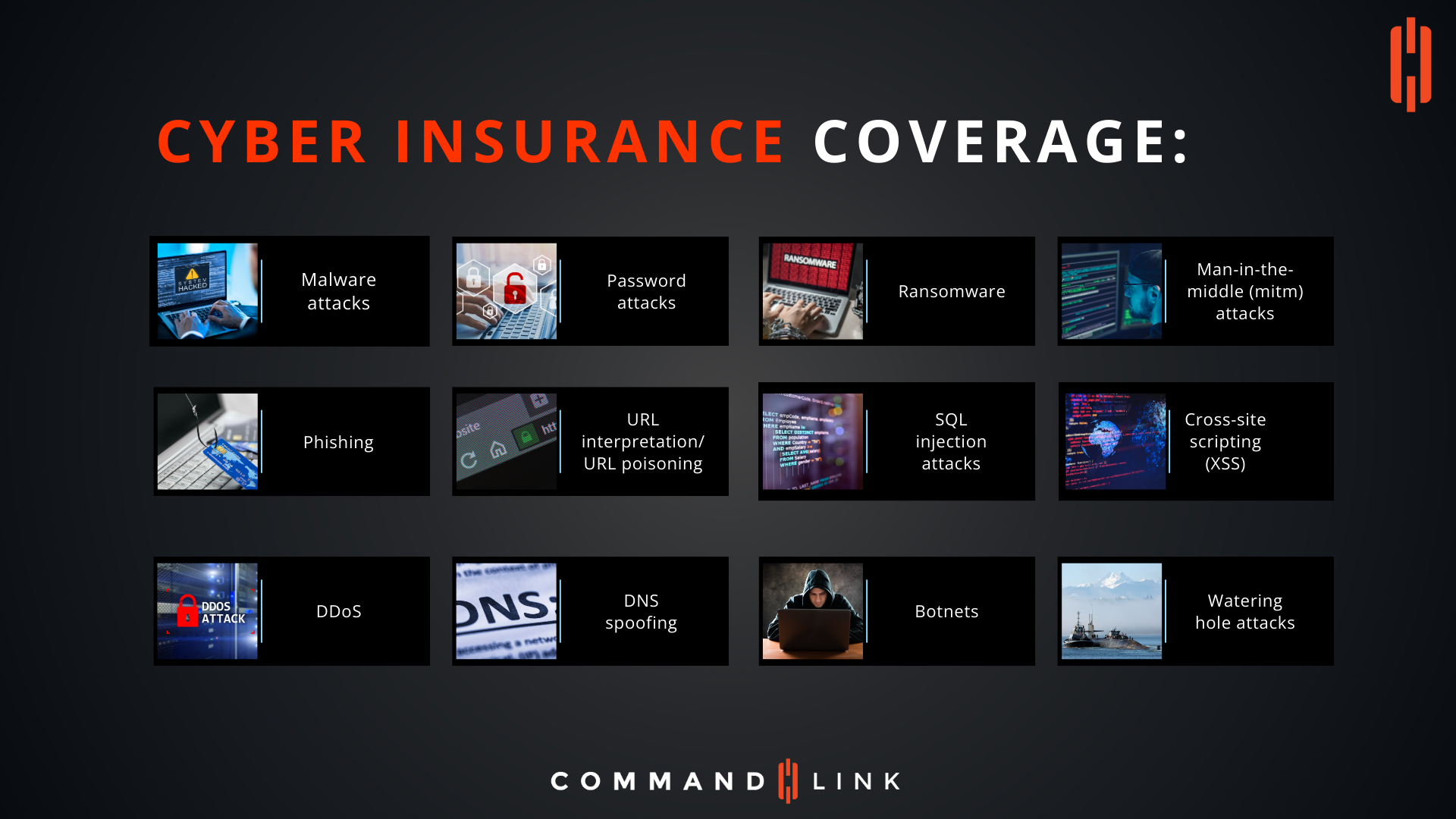Platform
Platform
Everything you need to run a secure global network—in a single system.
Solutions
Solutions
Learn how our solutions were designed to help you scale your IT resources
Company
CommandLink
Let's talk about how we can help you!
Partners

What Does Cyber Insurance Coverage Include?
In today’s digital landscape, cyber threats are becoming increasingly sophisticated and frequent. Organizations of all sizes are at risk, making cyber insurance a critical component of a comprehensive security strategy. Understanding what is covered by cyber insurance is essential to ensuring that your organization is protected against a wide range of cyber threats.
How Does Cyber Insurance Protect Against Malware Attacks?
Malware attacks are one of the most common and damaging cyber threats. Cyber insurance typically covers the costs associated with malware attacks, including the removal of the malware, recovery of data, and potential financial losses due to business interruption. This coverage is vital for organizations that rely heavily on digital operations.
Why Is Password Attack Coverage Important in Cyber Insurance?
Password attacks, such as brute force attacks or credential stuffing, can lead to unauthorized access to sensitive information. Cyber insurance provides coverage for the consequences of password attacks, including the costs of forensic investigations, legal fees, and notifying affected parties. This protection helps organizations mitigate the financial and reputational damage caused by such breaches.
What Role Does Cyber Insurance Play in Ransomware Attack Recovery?
Ransomware attacks are increasingly targeting organizations across all sectors. Cyber insurance offers coverage for the ransom payments, as well as the costs of data recovery and system restoration. In some cases, policies may also cover the expenses related to negotiating with attackers and coordinating with law enforcement.
How Does Cyber Insurance Address Man-in-the-Middle (MitM) Attacks?
Man-in-the-middle attacks involve intercepting and altering communications between two parties. Cyber insurance can cover the losses resulting from MitM attacks, including data breaches and unauthorized transactions. This coverage is essential for businesses that handle sensitive communications and financial transactions online.
Is Phishing Covered Under Cyber Insurance Policies?
Phishing remains a prevalent method used by cybercriminals to steal sensitive information. Cyber insurance typically covers the costs associated with phishing attacks, including the investigation, legal expenses, and potential financial losses. This coverage is crucial for protecting against the wide-reaching effects of phishing schemes.
What Are the Implications of URL Interpretation and URL Poisoning in Cyber Insurance?
URL interpretation or URL poisoning can lead to users being redirected to malicious sites. Cyber insurance policies often include coverage for the consequences of these attacks, such as data breaches and financial losses. This protection helps safeguard organizations against the risks associated with compromised URLs.
How Does Cyber Insurance Help with SQL Injection Attack Responses?
SQL injection attacks can expose sensitive data stored in databases by exploiting vulnerabilities in web applications. Cyber insurance provides coverage for the costs associated with mitigating SQL injection attacks, including forensic investigations, legal fees, and data recovery efforts. This coverage is vital for businesses that rely on databases to store critical information.
Does Cyber Insurance Cover Cross-Site Scripting (XSS) Attacks?
Cross-site scripting (XSS) attacks can be used to inject malicious scripts into web applications, potentially leading to data breaches and unauthorized access. Cyber insurance can cover the costs of responding to XSS attacks, including system remediation and legal expenses. This protection is important for organizations that operate web applications and services.
What Protection Does Cyber Insurance Offer Against DDoS Attacks?
Distributed Denial of Service (DDoS) attacks can cripple an organization’s online presence by overwhelming its servers with traffic. Cyber insurance typically covers the costs associated with mitigating DDoS attacks, including the expenses of restoring services and addressing potential financial losses. This coverage ensures business continuity in the face of disruptive attacks.
How Does Cyber Insurance Address DNS Spoofing and Botnets?
DNS spoofing and botnets are sophisticated cyber threats that can lead to significant data breaches and financial losses. Cyber insurance provides coverage for the costs associated with these attacks, including forensic investigations, legal fees, and system restoration. This protection helps organizations defend against complex, large-scale cyber threats.
What is the Importance of Cyber Insurance in Protecting Against Watering Hole Attacks?
Watering hole attacks target specific groups of users by infecting websites they are likely to visit. Cyber insurance covers the costs associated with these attacks, including the investigation, notification of affected parties, and potential legal fees. This coverage is essential for organizations that are at risk of being targeted by this type of cyberattack.